Debanjan Konar
A Scalable Quantum Non-local Neural Network for Image Classification
Jul 26, 2024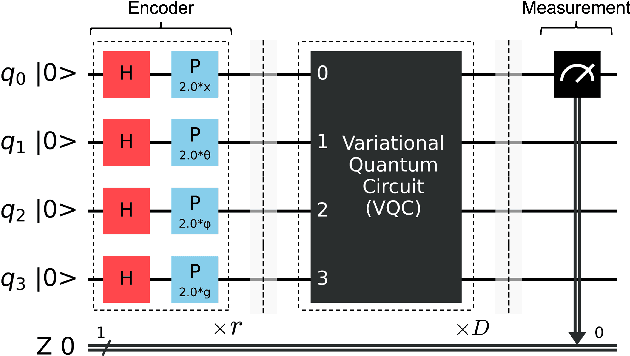
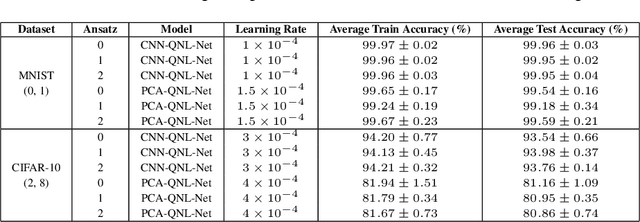


Abstract:Non-local operations play a crucial role in computer vision enabling the capture of long-range dependencies through weighted sums of features across the input, surpassing the constraints of traditional convolution operations that focus solely on local neighborhoods. Non-local operations typically require computing pairwise relationships between all elements in a set, leading to quadratic complexity in terms of time and memory. Due to the high computational and memory demands, scaling non-local neural networks to large-scale problems can be challenging. This article introduces a hybrid quantum-classical scalable non-local neural network, referred to as Quantum Non-Local Neural Network (QNL-Net), to enhance pattern recognition. The proposed QNL-Net relies on inherent quantum parallelism to allow the simultaneous processing of a large number of input features enabling more efficient computations in quantum-enhanced feature space and involving pairwise relationships through quantum entanglement. We benchmark our proposed QNL-Net with other quantum counterparts to binary classification with datasets MNIST and CIFAR-10. The simulation findings showcase our QNL-Net achieves cutting-edge accuracy levels in binary image classification among quantum classifiers while utilizing fewer qubits.
A Bi-directional Quantum Search Algorithm
Apr 24, 2024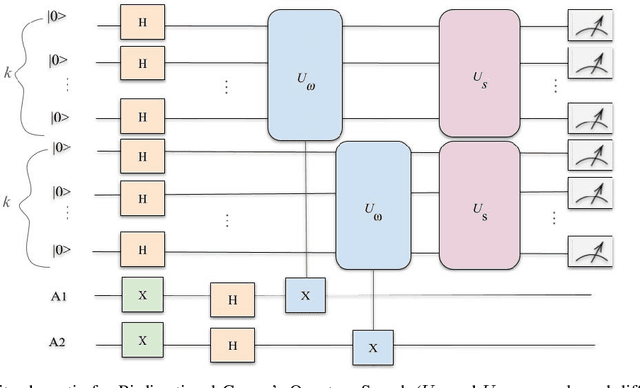
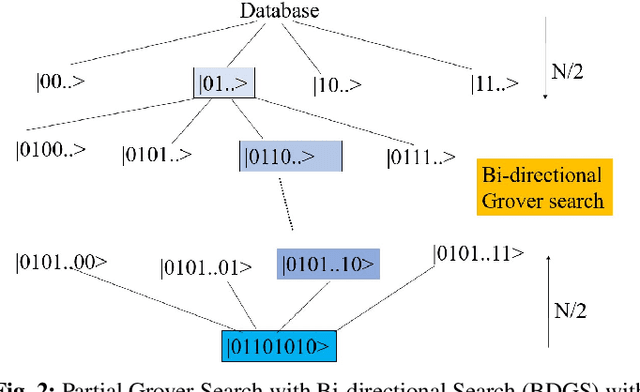
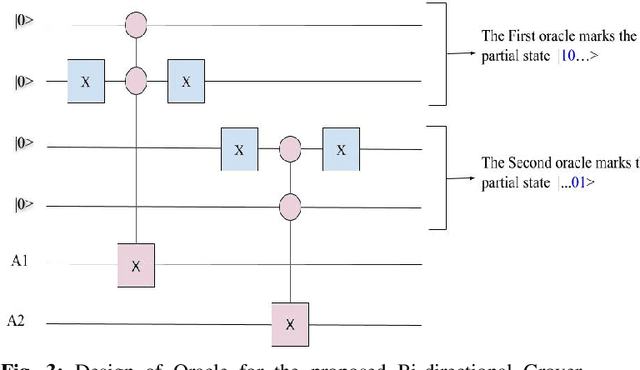
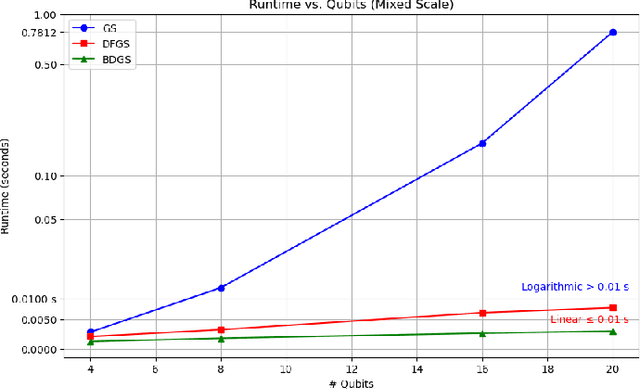
Abstract:Grover's search algorithms, including various partial Grover searches, experience scaling problems as the number of iterations rises with increased qubits, making implementation more computationally expensive. This paper combines Partial Grover's search algorithm and Bi-directional Search to create a fast Grover's quantum search algorithm, referred to as Bi-Directional Grover Search (BDGS). We incorporated a bi-directional search tactic with a partial Grover search, starting from an initial state and a single marked state in parallel. We have shown in this article that our novel approach requires $\frac{\pi}{4\sqrt{2}}\sqrt{N}(1-\sqrt{\frac{1}{b^{r/2k}}})$ iterations over regular Grover Search and Partial Grover Search (PGS), which takes $\frac{\pi}{4}\sqrt{N}\sqrt{1-\frac{1}{b}}$ (here, $N=2^r$ elements, $b$ is the branching factor of partial search, and $k= \lceil\log_2b \rceil$). The proposed BDGS algorithm is benchmarked against the state-of-the-art Depth-First Grover's Search (DFGS) and generic Grover's Search (GS) implementations for $2$ to $20$ qubits and provides promising results. The Qiskit Python implementation of the proposed BDGS algorithm is available on Github (https://github.com/hafeezzwiz21/DFGS-BDGS).
Tensor Ring Optimized Quantum-Enhanced Tensor Neural Networks
Oct 02, 2023



Abstract:Quantum machine learning researchers often rely on incorporating Tensor Networks (TN) into Deep Neural Networks (DNN) and variational optimization. However, the standard optimization techniques used for training the contracted trainable weights of each model layer suffer from the correlations and entanglement structure between the model parameters on classical implementations. To address this issue, a multi-layer design of a Tensor Ring optimized variational Quantum learning classifier (Quan-TR) comprising cascading entangling gates replacing the fully connected (dense) layers of a TN is proposed, and it is referred to as Tensor Ring optimized Quantum-enhanced tensor neural Networks (TR-QNet). TR-QNet parameters are optimized through the stochastic gradient descent algorithm on qubit measurements. The proposed TR-QNet is assessed on three distinct datasets, namely Iris, MNIST, and CIFAR-10, to demonstrate the enhanced precision achieved for binary classification. On quantum simulations, the proposed TR-QNet achieves promising accuracy of $94.5\%$, $86.16\%$, and $83.54\%$ on the Iris, MNIST, and CIFAR-10 datasets, respectively. Benchmark studies have been conducted on state-of-the-art quantum and classical implementations of TN models to show the efficacy of the proposed TR-QNet. Moreover, the scalability of TR-QNet highlights its potential for exhibiting in deep learning applications on a large scale. The PyTorch implementation of TR-QNet is available on Github:https://github.com/konar1987/TR-QNet/
A Scalable 5,6-Qubit Grover's Quantum Search Algorithm
Apr 30, 2022
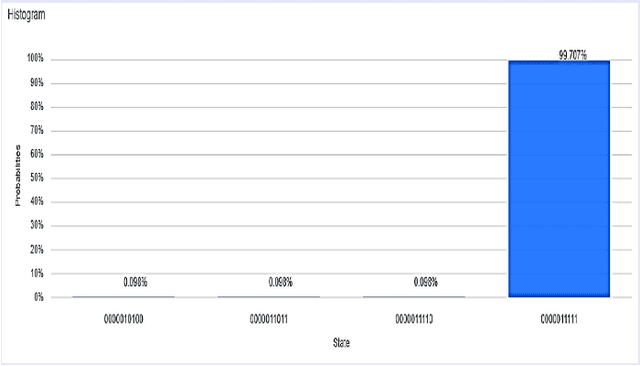
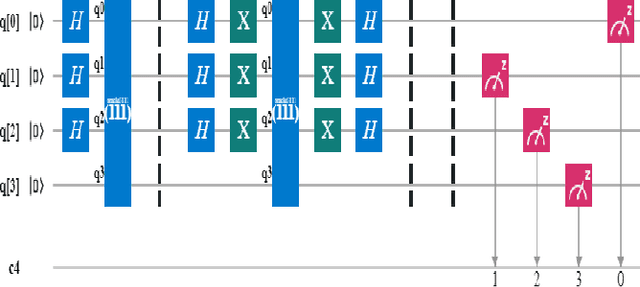
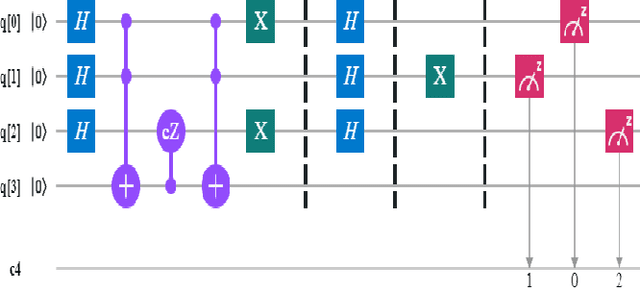
Abstract:Recent studies have been spurred on by the promise of advanced quantum computing technology, which has led to the development of quantum computer simulations on classical hardware. Grover's quantum search algorithm is one of the well-known applications of quantum computing, enabling quantum computers to perform a database search (unsorted array) and quadratically outperform their classical counterparts in terms of time. Given the restricted access to database search for an oracle model (black-box), researchers have demonstrated various implementations of Grover's circuit for two to four qubits on various platforms. However, larger search spaces have not yet been explored. In this paper, a scalable Quantum Grover Search algorithm is introduced and implemented using 5-qubit and 6-qubit quantum circuits, along with a design pattern for ease of building an Oracle for a higher order of qubits. For our implementation, the probability of finding the correct entity is in the high nineties. The accuracy of the proposed 5-qubit and 6-qubit circuits is benchmarked against the state-of-the-art implementations for 3-qubit and 4-qubit. Furthermore, the reusability of the proposed quantum circuits using subroutines is also illustrated by the opportunity for large-scale implementation of quantum algorithms in the future.
Random Quantum Neural Networks (RQNN) for Noisy Image Recognition
Mar 03, 2022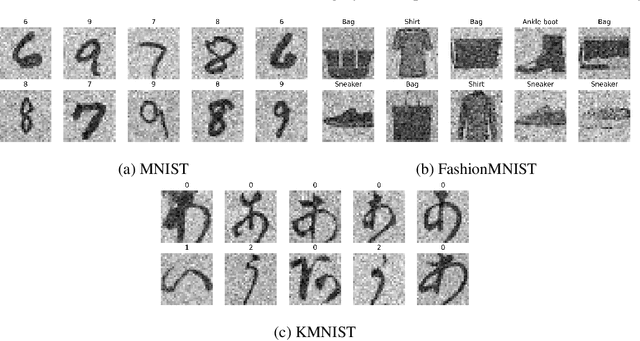

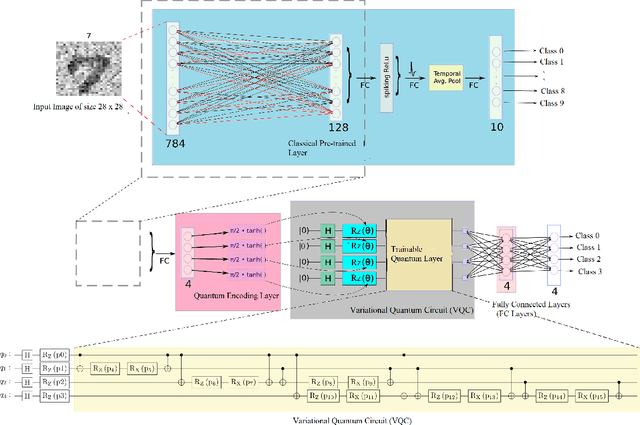

Abstract:Classical Random Neural Networks (RNNs) have demonstrated effective applications in decision making, signal processing, and image recognition tasks. However, their implementation has been limited to deterministic digital systems that output probability distributions in lieu of stochastic behaviors of random spiking signals. We introduce the novel class of supervised Random Quantum Neural Networks (RQNNs) with a robust training strategy to better exploit the random nature of the spiking RNN. The proposed RQNN employs hybrid classical-quantum algorithms with superposition state and amplitude encoding features, inspired by quantum information theory and the brain's spatial-temporal stochastic spiking property of neuron information encoding. We have extensively validated our proposed RQNN model, relying on hybrid classical-quantum algorithms via the PennyLane Quantum simulator with a limited number of \emph{qubits}. Experiments on the MNIST, FashionMNIST, and KMNIST datasets demonstrate that the proposed RQNN model achieves an average classification accuracy of $94.9\%$. Additionally, the experimental findings illustrate the proposed RQNN's effectiveness and resilience in noisy settings, with enhanced image classification accuracy when compared to the classical counterparts (RNNs), classical Spiking Neural Networks (SNNs), and the classical convolutional neural network (AlexNet). Furthermore, the RQNN can deal with noise, which is useful for various applications, including computer vision in NISQ devices. The PyTorch code (https://github.com/darthsimpus/RQN) is made available on GitHub to reproduce the results reported in this manuscript.
Qutrit-inspired Fully Self-supervised Shallow Quantum Learning Network for Brain Tumor Segmentation
Sep 14, 2020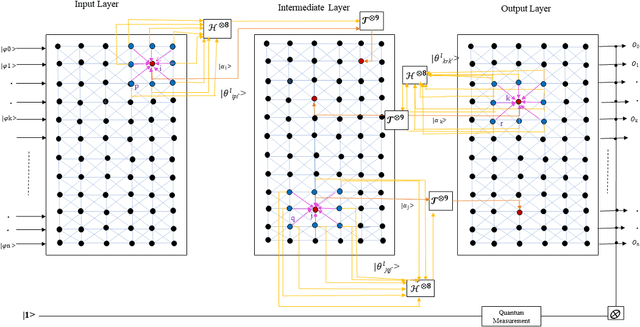

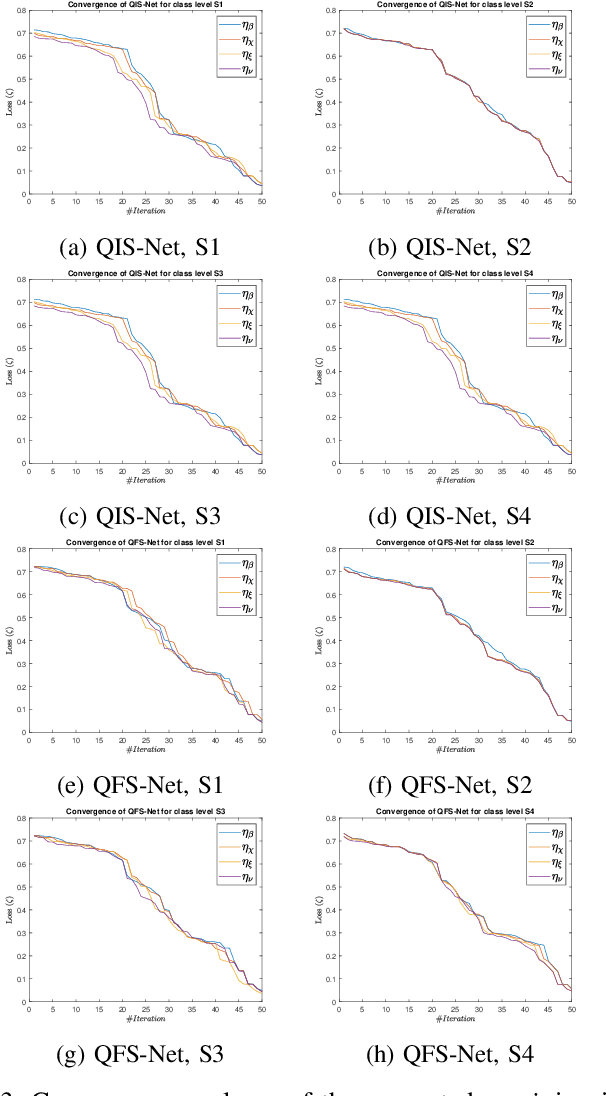

Abstract:Classical self-supervised networks suffer from convergence problems and reduced segmentation accuracy due to forceful termination. Qubits or bi-level quantum bits often describe quantum neural network models. In this article, a novel self-supervised shallow learning network model exploiting the sophisticated three-level qutrit-inspired quantum information system referred to as Quantum Fully Self-Supervised Neural Network (QFS-Net) is presented for automated segmentation of brain MR images. The QFS-Net model comprises a trinity of a layered structure of qutrits inter-connected through parametric Hadamard gates using an 8-connected second-order neighborhood-based topology. The non-linear transformation of the qutrit states allows the underlying quantum neural network model to encode the quantum states, thereby enabling a faster self-organized counter-propagation of these states between the layers without supervision. The suggested QFS-Net model is tailored and extensively validated on Cancer Imaging Archive (TCIA) data set collected from Nature repository and also compared with state of the art supervised (U-Net and URes-Net architectures) and the self-supervised QIS-Net model. Results shed promising segmented outcome in detecting tumors in terms of dice similarity and accuracy with minimum human intervention and computational resources.
 Add to Chrome
Add to Chrome Add to Firefox
Add to Firefox Add to Edge
Add to Edge